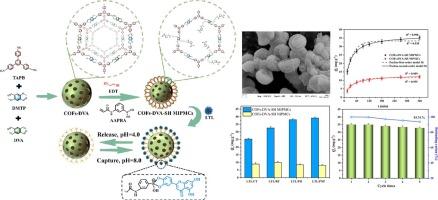基于共价有机框架的微球,具有精确设计的识别位点,用于选择性吸附木犀草素
IF 9
1区 工程技术
Q1 ENGINEERING, CHEMICAL
引用次数: 0
摘要
全球农业活动产生大量富含类黄酮的废物流,这既带来了资源回收的机会,也带来了环境挑战。由于黄酮类化合物的结构相似性,从复杂的基质中选择性分离高价值木犀草素(LTL)仍然是困难的。共价有机骨架(COFs)由于其结构和功能的可调,是一种很有前途的分离材料。然而,COFs在准确识别复杂环境矩阵中的LTL方面存在局限性。关键问题包括特异性结合位点不足和低功能化密度。为了克服这些挑战,我们通过一种新的乳化合成和后修饰策略开发了分子印迹COFs微球(COFs- dva - sh MIPMCs)。该方法包括通过乳液聚合构建中空乙烯基功能化COFs微球,然后通过巯基点击反应接枝二硫醇连接剂,最后进行硼酸亲和位点印迹。这产生了具有精确识别能力的COFs微球。COFs-DVA-SH MIPMCs结合了硼酸盐亲和力和分子印迹优势,能够选择性地提取LTL。在碱性条件下,它们具有显著的识别能力(67.97 mg g−1),快速传质(180 min)和高选择性(IF = 2.89)。吸附剂还表现出优异的稳定性,在5次 循环后保持93.7 %的容量和良好的热稳定性。本研究为利用COFs特异性分离天然黄酮类化合物提供了一种新的策略,并通过先进的分离技术支持农业废弃物的可持续增值。本文章由计算机程序翻译,如有差异,请以英文原文为准。


Covalent organic frameworks-based microspheres with precisely designed recognition sites for selective adsorption of luteolin
Global agricultural activities generate substantial flavonoid-rich waste streams, which presents both resource recovery opportunities and environmental challenges. The selective separation of high-value luteolin (LTL) from such complex matrices remains difficult due to structural similarities among flavonoids. Covalent organic frameworks (COFs) are promising separation materials due to their tunable structures and functionalities. However, COFs face limitations in accurately recognizing LTL within complex environmental matrices. Key issues include insufficient specific binding sites and low functionalization density. To overcome these challenges, we developed molecularly imprinted COFs microspheres (COFs-DVA-SH MIPMCs) through a novel emulsion-based synthesis and post-modification strategy. This approach involved constructing hollow vinyl-functionalized COFs microspheres via emulsion polymerization, followed by dithiol linker grafting through thiol-ene click reaction, and culminating in boronic acid affinity site imprinting. This yielded COFs microspheres with precise recognition capabilities. The COFs-DVA-SH MIPMCs combine boronate affinity with molecular imprinting advantages to enable selective LTL extraction. They demonstrate significant recognition capacity (67.97 mg g−1), rapid mass transfer (180 min), and high selectivity (IF = 2.89) under alkaline conditions. The adsorbent also exhibits excellent stability, maintaining 93.7 % capacity after 5 cycles and robust thermal stability. This work provides a new strategy for specific separation of natural flavonoids using COFs, supporting sustainable valorization of agricultural waste through advanced separation technologies.
求助全文
通过发布文献求助,成功后即可免费获取论文全文。
去求助
来源期刊

Separation and Purification Technology
工程技术-工程:化工
CiteScore
14.00
自引率
12.80%
发文量
2347
审稿时长
43 days
期刊介绍:
Separation and Purification Technology is a premier journal committed to sharing innovative methods for separation and purification in chemical and environmental engineering, encompassing both homogeneous solutions and heterogeneous mixtures. Our scope includes the separation and/or purification of liquids, vapors, and gases, as well as carbon capture and separation techniques. However, it's important to note that methods solely intended for analytical purposes are not within the scope of the journal. Additionally, disciplines such as soil science, polymer science, and metallurgy fall outside the purview of Separation and Purification Technology. Join us in advancing the field of separation and purification methods for sustainable solutions in chemical and environmental engineering.
 求助内容:
求助内容: 应助结果提醒方式:
应助结果提醒方式:


